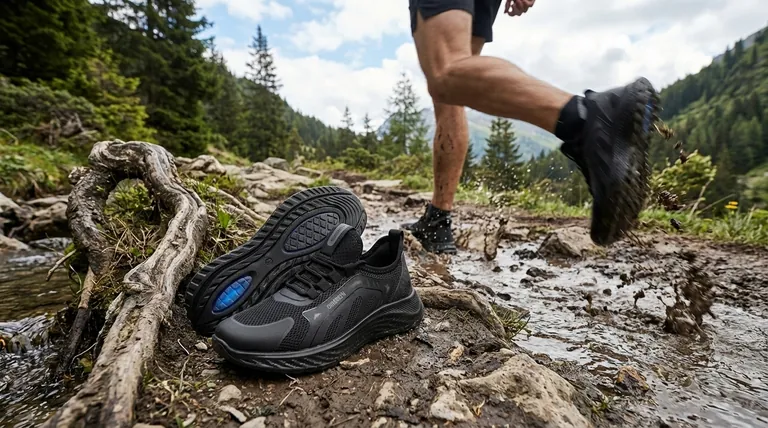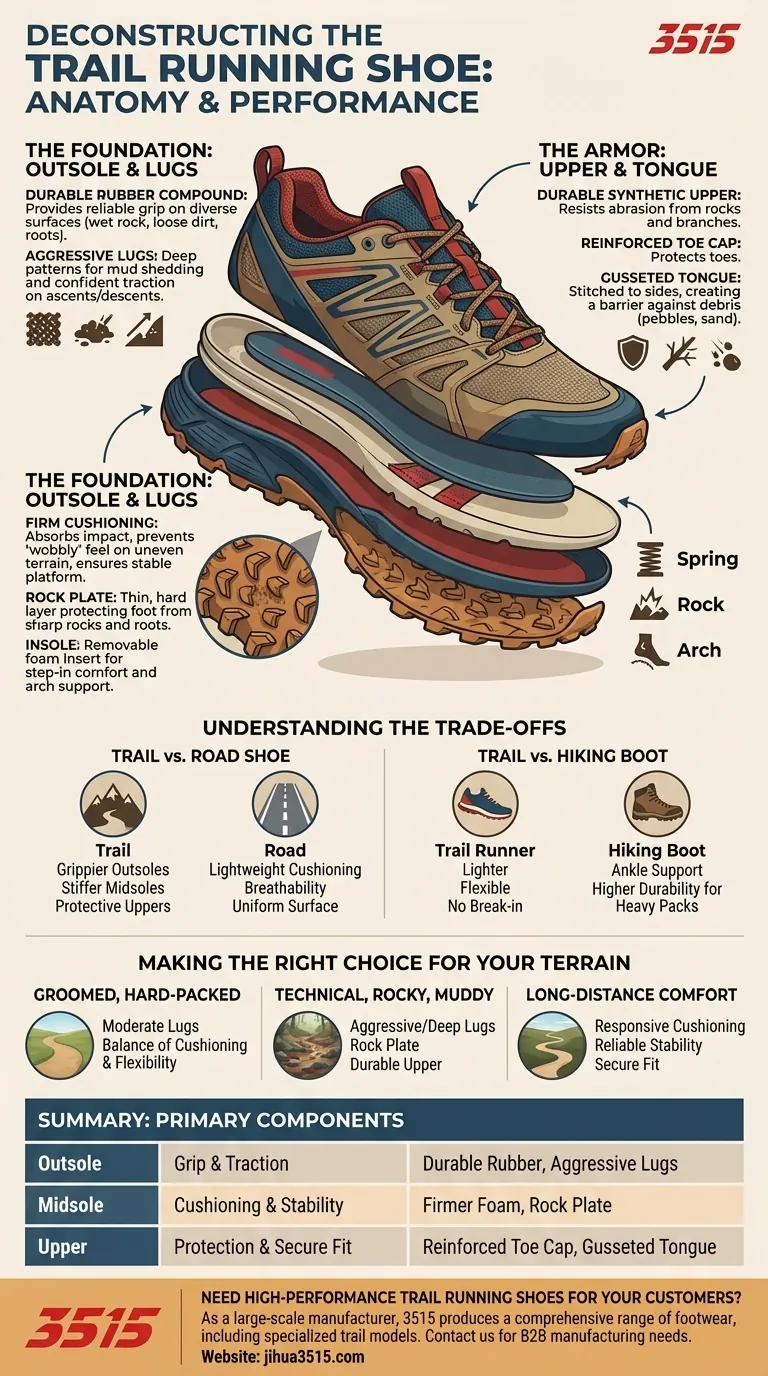Understanding the anatomy of a trail running shoe reveals that it's far more than just a standard running shoe with extra tread. Each component is a piece of specialized equipment, working in concert to provide traction, protection, and stability on unpredictable terrain. The primary components are the outsole for grip, the midsole for cushioned stability, and the upper for protection and a secure fit.
A trail running shoe is an engineered system where every part is optimized for the unique demands of off-road environments. Unlike road shoes that prioritize plush cushioning, trail shoes prioritize grip, foot protection, and stability on uneven ground.

The Foundation: Outsole and Lugs
The outsole is your shoe's direct connection to the trail. Its design and materials are arguably the most critical features defining a trail shoe.
The Outsole: Your Connection to the Ground
The outsole is the bottom-most layer of the shoe, typically made of a durable, "sticky" rubber compound. This material is formulated to provide reliable grip on diverse surfaces like wet rock, loose dirt, and tangled roots.
Lugs: The Shape of Traction
Lugs are the deep, aggressive patterns molded into the outsole. Their depth, shape, and spacing determine how the shoe performs in specific conditions. Widely spaced, deep lugs excel at shedding mud, while multi-directional patterns provide confident grip during ascents and descents.
The Engine: Midsole and Insole
The midsole is the workhorse of the shoe, managing both shock absorption and stability. It's where the shoe's "feel" is truly born.
The Midsole: Cushioning Meets Stability
Located between the outsole and your foot, the midsole absorbs impact. In trail shoes, this foam is often firmer and stiffer than in road shoes. This intentional design prevents the shoe from feeling "wobbly" on uneven terrain and provides a more stable platform.
Many trail shoes also embed a rock plate—a thin, hard layer within the midsole—to protect the bottom of your foot from sharp rocks and roots.
The Insole: The Layer of Comfort
The insole, or sockliner, is the removable foam insert inside the shoe. Its primary role is to provide initial step-in comfort and a small degree of arch support.
The Armor: Upper and Tongue
The upper is everything that wraps around the top and sides of your foot. Its job is to provide a secure lockdown while simultaneously shielding you from the elements of the trail.
The Upper: A Shield for Your Foot
The upper is constructed from durable, often synthetic, materials designed to resist abrasion from rocks and branches. Features like reinforced toe caps (toe bumpers) and overlays add significant protection where it's needed most.
The Tongue: The First Line of Defense
Beyond providing padding for the top of your foot, many trail shoes feature a gusseted tongue. This means the tongue is stitched to the sides of the upper, creating a barrier that is highly effective at keeping pebbles, sand, and other trail debris out of your shoe.
Understanding the Trade-offs
Choosing a trail running shoe means balancing competing needs. No single shoe is perfect for every runner or every trail.
Trail Shoe vs. Road Shoe
The core difference is purpose. Trail shoes have grippier outsoles, stiffer midsoles, and more protective uppers. Road shoes are built for repetitive impact on a uniform surface, prioritizing lightweight cushioning and breathability.
Trail Shoe vs. Hiking Boot
Compared to a hiking boot, a trail runner is significantly lighter and more flexible, with no break-in time required. The trade-off is a lack of ankle support and less overall durability, making them less ideal for carrying heavy packs over rugged terrain.
The Water Resistance Question
Most standard trail running shoes are not waterproof. They are designed to be breathable, allowing water to drain and dry quickly. Waterproof (e.g., Gore-Tex) versions exist, but they are less breathable and can feel hot in warm weather.
Making the Right Choice for Your Terrain
The ideal shoe depends entirely on where and how you plan to run.
- If your primary focus is well-groomed, hard-packed trails: You can prioritize a shoe with moderate lugs and a good balance of cushioning and flexibility.
- If your primary focus is technical, rocky, or muddy terrain: Look for aggressive, deep lugs, a protective rock plate in the midsole, and a durable, reinforced upper.
- If your primary focus is long-distance comfort on varied trails: Seek a shoe with a proven balance of responsive cushioning, reliable stability, and a secure-fitting upper.
By understanding how each component serves a purpose, you can confidently select the shoe that will act as the right tool for your specific adventure.
Summary Table:
| Component | Primary Function | Key Features |
|---|---|---|
| Outsole | Provides grip and traction | Durable rubber compound, aggressive lugs for mud and rock |
| Midsole | Cushioning and stability | Firmer foam, often includes a rock plate for protection |
| Upper | Protection and secure fit | Reinforced toe cap, gusseted tongue to keep debris out |
Need high-performance trail running shoes for your customers? As a large-scale manufacturer, 3515 produces a comprehensive range of footwear for distributors, brand owners, and bulk clients. Our production capabilities encompass all types of shoes and boots, including trail running models designed for superior grip, durability, and comfort. Let us help you equip your customers with the right footwear for any adventure. Contact us today to discuss your manufacturing needs!
Visual Guide

Related Products
- Wholesale Breathable & Cushioned Training Shoes Custom Factory Production
- Durable Rubber-Soled Utility Shoes for Wholesale & Custom Brand Manufacturing
- Wholesale Durable & Breathable Training Shoes for Custom Brands
- Advanced KPU Athletic Safety Shoe with Steel Toe Cap Anti-Slip Rotary Lacing System
- Safety Footwear Wholesale Manufacturer for Custom OEM/ODM Production
People Also Ask
- Does more ground contact area mean better support? Unlock the Secrets of Stable Footwear
- How does flexibility differ between running and walking shoes? A Guide to Choosing the Right Footwear
- Are non-slip shoes affordable? Yes, and Here’s How to Get the Best Value
- What are the benefits of athletic-style work shoes? Boost Comfort and Safety for Your Team
- What are the features of non-slip athletic sneakers? The Ultimate Guide to Traction & Performance



















